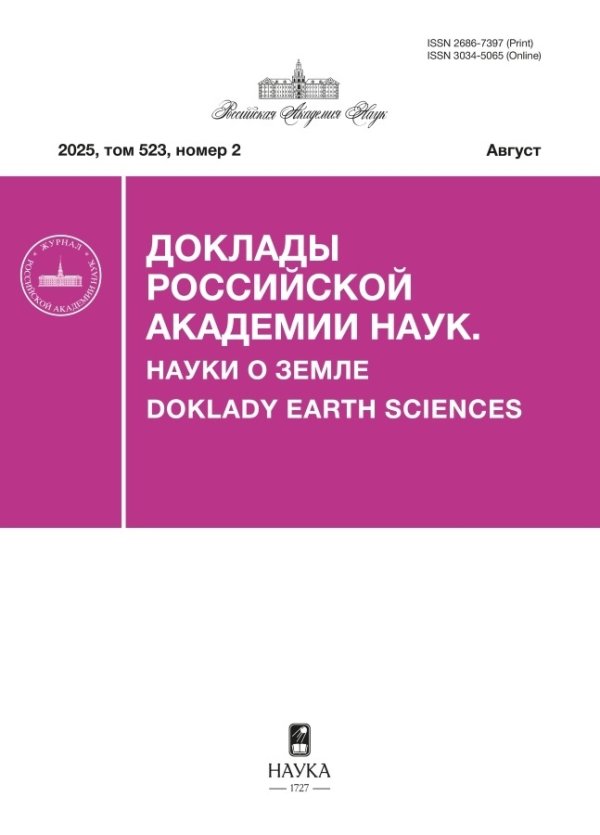Gas shows within the southeastern shelf of the Crimea according to continuous seismoacoustic profiling data
- Authors: Khortov А.V.1, Pronin A.A.1, Rimsky-Korsakov N.А.1, Mutovkin A.D.1
-
Affiliations:
- P.P. Shirshov 1nstitute of Oceanology, Russian Academy of Sciences
- Issue: Vol 520, No 1 (2025)
- Pages: 74-81
- Section: GEOLOGY OF OIL AND GAS
- Submitted: 03.06.2025
- Published: 30.05.2025
- URL: https://vestnik.nvsu.ru/2686-7397/article/view/682407
- DOI: https://doi.org/10.31857/S2686739725010071
- EDN: https://elibrary.ru/GWWIEE
- ID: 682407
Cite item
Abstract
The research was carried out by a team from the Institute of Oceanology of the Russian Academy of Sciences during the expeditions of the research vessels (RV) “Peleng” of the Sevastopol branch of the State Oceanographic Institute and “Professor Vodyanitsky” of the Federal Research Center InBYuM (115th, 116th, 124th and 126th voyages) in 2018–2023 in accordance with the Plan of Marine Expeditions on Research Vessels of the Ministry of Education and Science of Russia. At the same time, the tasks of depth measurements, continuous seismic profiling (CSAP) and acoustic sounding of sedimentary deposits, as well as panoramic survey of the bottom surface using a side-scan sonar were solved. The objectives of the study included: firstly, obtaining new geological and geomorphological data on the history of the development of the Crimean Peninsula shelf, necessary for restoring poorly studied stages of the paleogeographic history of the formation of the continental margin of Crimea in modern times, which will clarify the existing ideas about the change in the Black Sea level, and secondly, obtaining new geological and geomorphological data on the paleogeomorphology of the Crimean Peninsula shelf, which will clarify the position of the ancient hydrographic network and establish the connections of coastal and subaqueous morphostructures. In the process of interpreting continuous seismoacoustic profiling (CSAP) data, anomalous areas identified with gas accumulations were identified in the bottom part of the section.
Full Text
About the authors
А. V. Khortov
P.P. Shirshov 1nstitute of Oceanology, Russian Academy of Sciences
Author for correspondence.
Email: khortov.av@ocean.ru
Russian Federation, Moscow
A. A. Pronin
P.P. Shirshov 1nstitute of Oceanology, Russian Academy of Sciences
Email: khortov.av@ocean.ru
Russian Federation, Moscow
N. А. Rimsky-Korsakov
P.P. Shirshov 1nstitute of Oceanology, Russian Academy of Sciences
Email: khortov.av@ocean.ru
Russian Federation, Moscow
A. D. Mutovkin
P.P. Shirshov 1nstitute of Oceanology, Russian Academy of Sciences
Email: khortov.av@ocean.ru
Russian Federation, Moscow
References
- Мейснер Л. Б., Туголесов Д. А. Флюидогенные деформации в осадочном выполнении Черноморской впадины // Разведка и охрана недр. 1997. № 7. С. 18–22.
- Шнюков Е. Ф., Пасынков А. А., Клещенко С. А. и др. Газовые факелы на дне Черного моря. Киев, 1999. 133 с.
- Глебов А. Ю., Круглякова Р. П., Шелыпинг С. Л. Естественные выделения углеводородных газов в Черном море // Разведка и охрана недр. 2001. № 8. С. 19–22.
- Шнюков Е. Ф., Старостенко В. И., Русаков О. М., Кутас Р. И. Глубинная природа газовых факелов западной части Черного моря по результатам геофизических исследований // Геол. и полезн. ископ. Мирового океана. 2005. № 5. С. 70–82.
- Круглякова Р. П., Круглякова М. В., Шевцова Н. Т. Геолого-геохимическая характеристика естественных проявлений углеводородов в Черном море // Геология и полезные ископаемые Мирового океана. 2009. № 1. С. 37–51.
- Шнюков Е. Ф., Коболев В. П., Пасынков А. А. Газовый вулканизм Черного моря. Киев: “Логос”, 2013. 384 с.
- Римский-Корсаков Н. А., Пронин А. А., Хортов А. В. и др. Технология и результаты сейсмоакустического профилирования на шельфе Крыма в 124 рейсе НИС “Профессор Водяницкий” // Международный журнал прикладных и фундаментальных исследований. № 2. 2023. С. 37–43.
- Римский-Корсаков Н. А., Пронин А. А., Мутовкин А. Д. и др. Cейсмостратиграфия материковой окраины Крыма по данным сейсмоакустического профилирования / В сборнике: “Состояние и перспективы ГРР на нефть и газ на континентальном шельфе Российской Федерации”, 1–2 июня 2023 года. Вып. 2. СПб.: ВНИИОкеангеология, 2023. 86 с.
- Хортов А. В., Римский-Корсаков Н. А., Пронин А. А. и др. Сейсмостратиграфические исследования крымского шельфа методом непрерывного сейсмоакустического профилирования // Доклады РАН. Науки о Земле. 2023. Т. 512. № 2. С. 134–140.
- Димитров Л. Л. Газово-акустические аномалии осадочного чехла Болгарского Черноморского шельфа // Геологическая эволюция западной части Черноморской котловины в неоген-четвертичное время. София: Изд-во Болгарской академии наук, 1990. С. 362–380.
- Гайнанов В. Г. О природе ярких пятен на временных разрезах сейсмоакустического профилирования // ГЕОразрез. Электронный научный журнал университета “Дубна”. 2008. № 2. С. 1–18.
- Мараев С. Л., Хортов А. В. Вертикальные деструктивные флюидоразгрузочные зоны Каспия как разновидность геологических опасных явлений // Научный журнал Российского газового общества. Раздел Геоэкология. 2022. № 1. С. 30–35.
- Шнюков Е. Ф., Пасынков А. А., Любицкий А. А. и др. Формы рельефа дна Черного моря как возможные проявления современной геодинамической активности // Геол. и полезн. ископ. Мирового океана. 2012. № 2. С. 99–103.
- Малахова Т. В., Канапацкий Т. А., Егоров В. Н. и др. Микробные процессы и генезис струйных метановых газовыделений прибрежных районов Крымского полуострова // Микробиология. 2015. Т. 84. № 6. С. 743–752.
- Малахова Т. В., Малахова Л. В., Мурашова А. И. и др. Мониторинг мелководных сипов у мыса Фиолент (Черное море) // Океанология. 2023. Т. 63. № 1. С. 135–148.
- Kruglyakova R. P., Byakov Y. A., Kruglyakova M. V. et al. Natural oil and gas seeps of the Black Sea floor // Geo-Marine Letters. 2004. № 23. P. 193–201.
- Евсюков Ю. Б., Руднев В. И. Геоморфология и неотектоническое преобразование материковой отмели в западной части Черного моря // Геология, география и глобальная энергия. 2013. № 3(50). С. 46–55.
- Есин Н. И., Хортов А. В. Динамика вертикальных движений земной коры в голоцене // Экология гидросферы. 2022. № 2 (8). С. 47–68.
- Миронюк С. Г., Клещин С. М. Опыт применения геофизических методов с целью идентификации морских геологических опасностей // ГеоИнжиниринг. 2010. № 1. С. 48–54.
- Миронюк С. Г., Маркарьян В. В., Шельтинг С. К. Опыт комплексной оценки и крупномасштабного инженерно-геологического районирования северо-восточного шельфа Черного моря по геологической опасности для строительства линейных объектов // Инженерные изыскания. 2013. № 13. С. 48–59.
Supplementary files

Note
Presented by Academician of the RAS M.F. Fedonkin July 8, 2024















